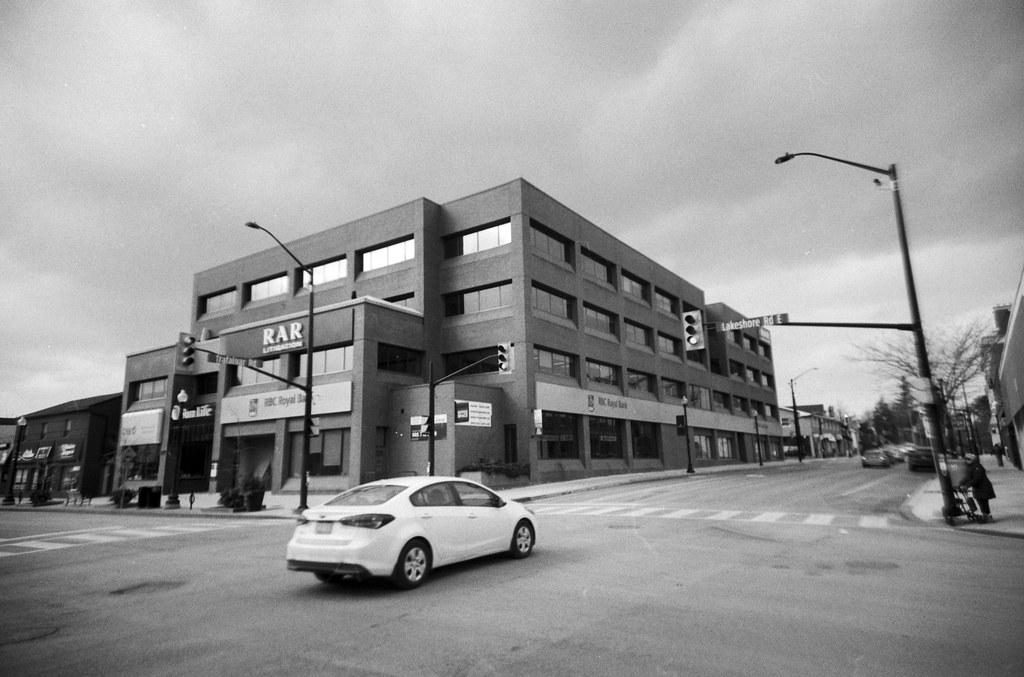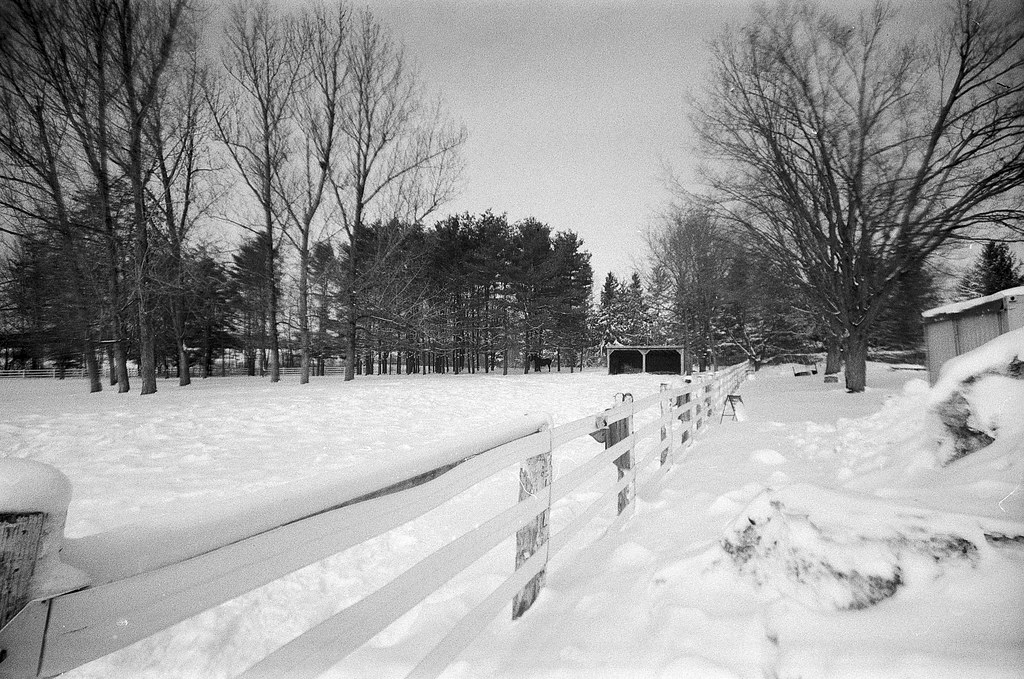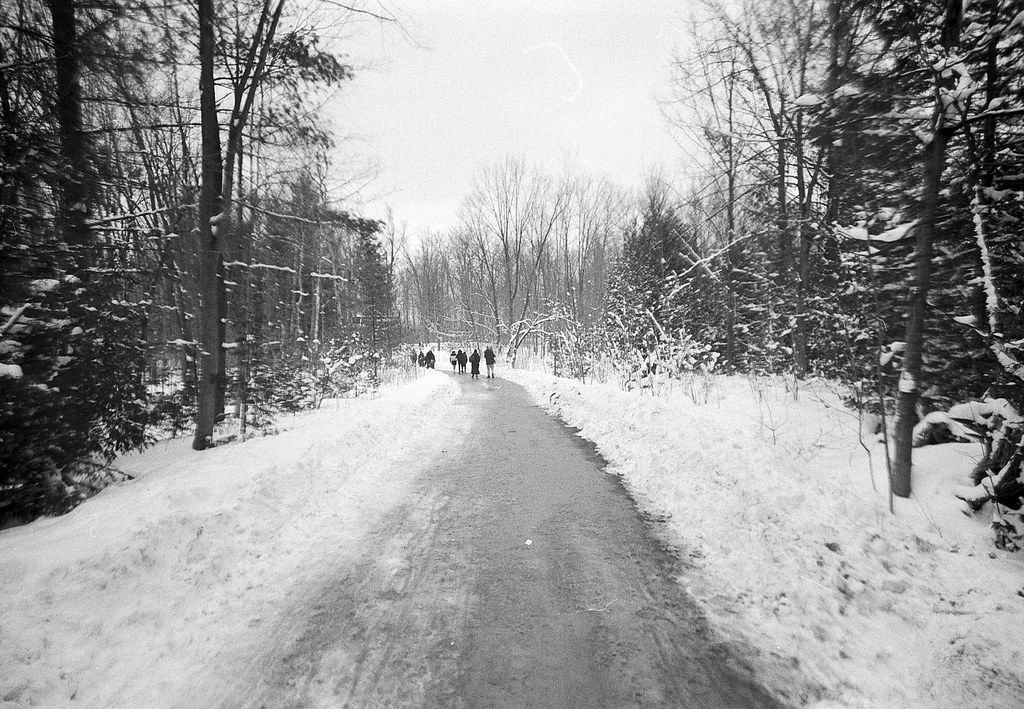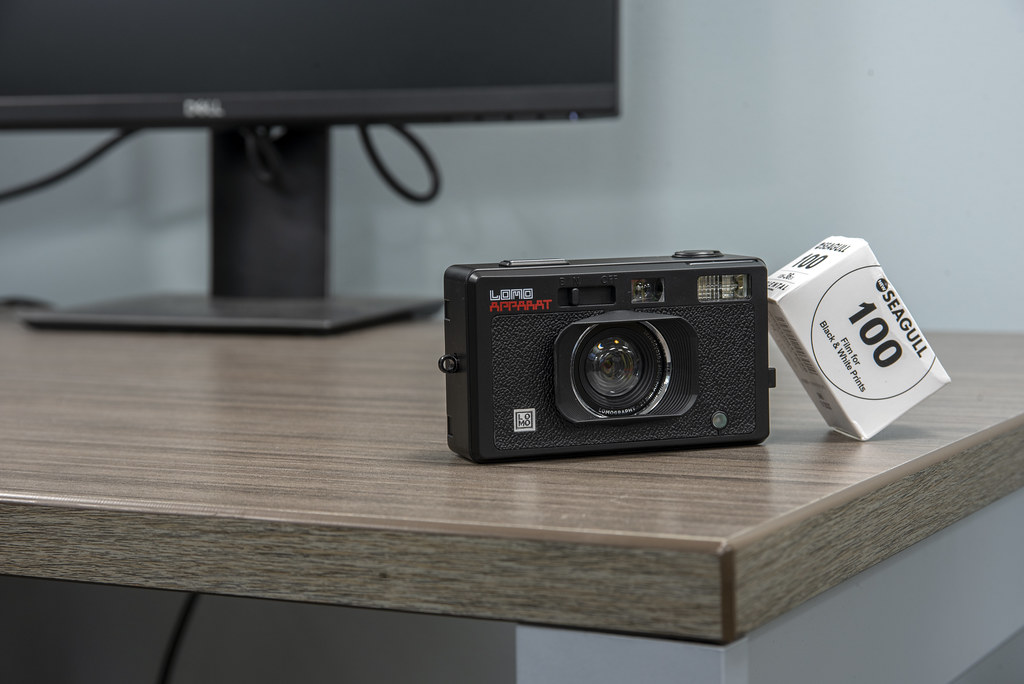I did not think I would enjoy working with these sorts of cameras. Sort of like how I felt about the RETO Ultra Wide & Slim, the LOMO APPARAT is a simple-use camera centred around an ultra-wide angle lens. But the APPARAT has some other tricks that the RUWS does not have; first, there’s a built-in flash, and second, this camera is far bigger than RUWS. Like all Lomography cameras, it’s centred around making photography fun, abandoning the traditional ideas of sharpness and accuracy. Shoot from the hip and see what happens. But you can quickly determine the different quirks. The APPARAT gives the photographer. With the flash and additional optical accessories, there’s plenty of room for play and experimentation.
Camera Specifications
Make: Lomography
Model: LOMO APPARAT
Type: Point-And-Shoot
Format: 35mm (135), 36x24mm
Lens: Fixed, Lomography – 21mm Analogue FotoApparat f/10
Shutter: Leaf Shutter, 1/100″ + Bulb
Dimensions (WxHxD): 148x69x38mm (based on personal measurements)
Weight: 150g (w/o battery, based on personal measurements)
Power Source: 1x AA Battery (Flash Only)
Year of Manufacture: 2022-Present
Background
The trouble with a new camera is that there is no background to share. However, Lomography has a long and excellent history that is worth exploring. And it all started with the LOMO LC-A. The LC-A, or Lomo Kompakt Automat, came out in 1984 based on the Cosina CX-2. It was produced by the legendary Leningrad Optical Mechanical Association (Ленинградское Oптико-Mеханическое Oбъединение) or LOMO. The LC-A was an auto-exposure, manual zone focus point-and-click camera with a Minitar-1 triplet design lens. While rarely seen west of the Iron Curtain, a group of Viennese students came across this camera in a junk shop in Prague. Purchasing the LC-A, they fell in love with the deep colour saturations, fall-off, and vignetting. Forming the Lomographic Society International in 1992, the group lobbied LOMO to continue the manufacture of the LC-A for their new group after production stopped in 1994. Soon society began to lobby for producing other ‘lo-fi’ cameras, such as 1998’s four-lens Actionsampler and 2000’s Supersampler. An LC-A+ hit markets in 2006; a Chinese made a copy of the camera that launched the society. Soon other iconic toy cameras, like the Diana+ and Lubitel+, were being produced for Lomography. Now thirty years on, the LOMO APPARAT is the ethos of Lomography in a camera form, with a simple quirky camera that allows one to shoot from the hip and not think too hard.




Impressions
If you’re familiar with Soviet-era cameras, the APPARAT might look like the compact cameras of the 1980s, like the Elikon line of cameras such as the Orion-35C. The APPARAT is a handsome camera and is available in two finishes. My copy is the all-black version, the less expensive of the two. The other finish uses a cream with tan Italian leather on the body panels with additional blue highlights. The camera is constructed almost entirely from plastic, but some metal components exist. Despite this, the camera itself has a decent weight; there’s no forgetting that there is a camera in your hand. But the weight and balance of the camera are comfortable, and a metal wrist strap keeps your camera secure. Sadly there is only a single lug, so that a neck strap might take a bit of rigging. There is a standard tripod socket on the base of the camera. The 21mm lens has an integral lens hood that also acts to stop the user from sticking their finger into the frame and as a mount for the optical accessories. There is a dedicated on/off switch; while in off, the flash is powered down, and there’s an interlock that prevents tripping the shutter; in “N” mode, the shutter operates in normal mode (~1/100″), and there’s also “B” or bulb mode, but there is no remote shutter release socket. The film advance is a dial-type at the back, and there is also a dedicated Multi-Exposure (MX) switch. The shutter release is a wide rectangle at the top. The weak point of the camera remains the film rewind knob, but as you only use it for rewinding the film, you can be gentle during that process. Overall I find the camera well built for being a simple-use camera, and while I wouldn’t drop it from any great height, it should be able to take a few hits without too much trouble.




Experiences
There will be frustration if you’re not used to working with these cameras. Unlike a camera like the RETO Ultra Wide & Slim, there is a certain level of control that you do have with the APPARAT, but nothing to the level that you might be used to. The APPARAT is an ‘ish’ camera, which means you have a fixed shutter speed of 1/100″ (ish), a fixed aperture of f/10 (ish), and a fixed focal length of 21mm (ish). That said, there is some level of control, you can set the camera to bulb mode and keep the shutter open as long as you hold the shutter button down, and there is no input for a remote release. And there is an internal flash. So the APPARAT has a few more tricks than other cameras in this class. The dedicated on/off switch includes a shutter release lockout and has two ‘on’ positions, “n” for Normal or that 1/100″ shutter speed and “B” for the Bulb. The flash will always fire as long as it has power supplied by a single AA battery. So if you don’t need or want a flash, pull the battery. Loading the film is tricky, as the obvious way of tucking the leader in the metal tab is not the correct method; instead, lay the leader across and ensure that the sprockets are engaged on both the take-up spool and above the shutter window. It’s tricky, and you won’t get it right the first couple of times, but be patient and use slow movements. Once the film is loaded, it’s time to have fun! The viewfinder is helpful and does give a rough idea, but the 21mm lens means you can quickly shoot from the hip; I stick with the viewfinder primarily out of habit. The optical accessories are easily slid on and off the lens hood/mount, and the box contains all the accessories for the camera. The camera only has a single mounting lug, so you can use the wrist strap (also included in the box), and with the weight, you know you have the camera on your person. The flash also comes with different gel filters to help expand your creativity. With some of these accessories and in the spirit of Lomography, multiple exposures are a big draw to the APPARAT. The Multi-Exposure is easily achieved; there’s no trick, no gimmick. A well-placed and easy-to-use switch on the camera back allows you to disengage the advance and cock the shutter. The one thing I find odd that was missed in the whole thing is a dedicated rewind release button; while you can rewind by turning the camera off and holding the MX button, you can rewind your film. It is a rough rewind as the rewind knob is not the strongest part of the camera. Despite its frustrating aspects, the APPARAT holds to Lomography’s ideals as it is a fun, experimental, creative camera. But it certainly is not for everyone.




Optics
The biggest draw of the APPARAT for me is the wide-angle lens, and this camera has a lens that is the widest of its class, a whopping 21mm. Combined with a fixed f/10 aperture, this focal length means you can get everything in your frame and almost everything in focus. The lens is a single-element plastic that deals with all the unique characteristics you would expect from such a lens. The lens is surprisingly sharp but mainly within the centre of the image, with some fall-off towards the corners but no vignetting. The lens characteristic is helped along by the curved film plane and back pressure plate. A lens this wide does tend to flare; there is an integral hood, which does help. But the lens acts as a mount for the optical accessories for the camera. And the box comes with three accessories, the close-up filter, kaleidoscope, and a splitter. The close-up filter turns the wide-angle lens into a unique portrait taker, while the kaleidoscope attachments give your images a funky multi-faceted look. The splitter helps you make creative multi-exposure by blocking off part of the frame to allow for added creative control.




Lowdown
The APPARAT is not a camera for everyone. As a toy camera, it can have some things that photographers who love a great deal of control and are concerned about image quality and proper exposure might find off-putting. And that’s fair; Lomography is often designed for those who are into photography for fun and experimentation. And while I seem to like the photographer concerned about quality and exposure, that is true in some situations. But the APPARAT is a camera that may not be one I pick up regularly, but it can offer a fun, low-key experience with photography when I want to shoot from the hip and focus on playing with the camera’s unique quirks. And that is the one thing that I do find with the APPARAT is that despite being what it is, the camera is predictable, which means you can easily compose your images to take advantage of these characteristics. What also makes the APPARAT a good camera is that it offers up an affordable introduction into the world of toy cameras; the black version costs 89$ while the two-tone version is 99$ (USD), and that cost includes the complete kit, camera, three optical accessories, wrist strap, lens cover, and an accessory bag. And you cannot complain about that when there are a lot of Lomography cameras that are far more expensive.
Watch for the Video Review later this year!
Further Reading
Don’t just take my word on the LomoApparat; you can check out the reviews by other excellent camera reviewers!
Emulsive.org – Camera review: Loving Lomography’s New LomoApparat 21mm wide-angle camera
PopPhoto – New gear: The LomoApparat 21mm Wide-angle film camera looks like fun
Lomography – First Impressions of the LomoApparat by Choi Mo
Lomography – Francesca Bianchi’s First Impressions of the LomoApparat
PCMag – Lomography LomoApparat Review


Thanks for the lowdown on this camera. I was torn between this and the Reto 3D and decided on the latter as I don’t have anything like it. This seems just like you said, like the vuws with extra features. Definitely a fun camera to play with if you haven’t got a camera like that already.
Nice photos. I hope to be getting one when funds allow.
yeha! geet one for chrisrtmals this winter.
I never thought I would get one but now I love it! Heres my take: i love it! YAY
I just bought a LomoApparat as my 1111 (November 11th the shopping day here) gift. Searching related articles, I am amased that you pick up a very old Seagull 100 fillm! It lets me recall my old days back in 1990s! I will try to take as good photos as yours!
Greetings from Wuxi, China.
This is new Seagull Film, which is repackaged Kentmere 100 and 400 films. Enjoy thr Apparat!